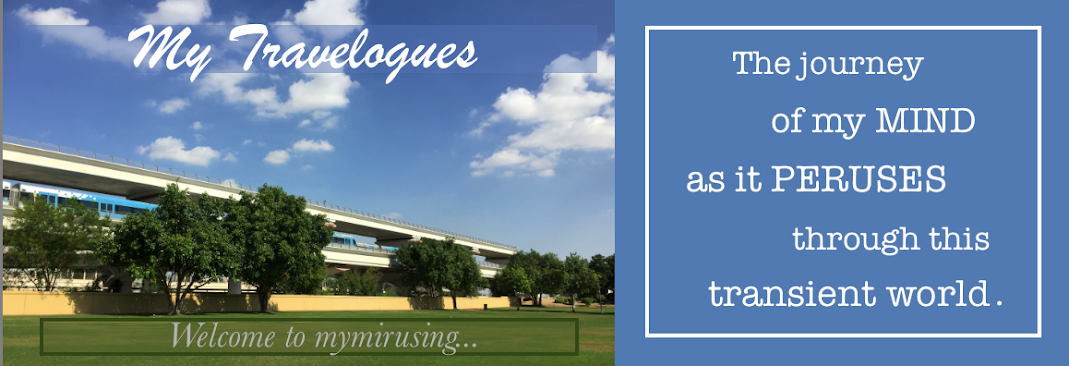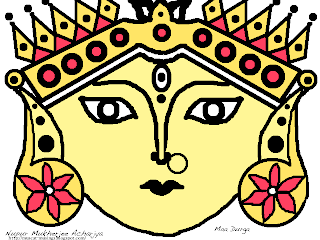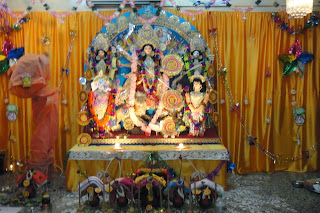A
few days back was Mahalaya which marks the official countdown to Durga Puja. As
Navratri sets in and Durga Pujo rings in, it is time for Bengalis to get geared
up for the Pujo Days. I have mentioned Navratri here because both the festivals
go hand in hand in many states of India especially in Gujarat (and I happily
enjoy both the festivals). Beginning from cleaning your houses, grooming
yourselves, for some shopping already done months in advance while for some
there is last minute shopping left in hand, and so much more fun. Not all of us
are lucky like Mamta Banerjee who recently got the opportunity to select
designs for Durga Puja sarees, nevertheless shopping for the Pujos is no less
fun.
For
Bengalis, Durga Pujo is more than a religious ceremony; it is the biggest
social event that we wait and plan for the entire year. Being a Probashi
Bengali (a Bengali living outside Bengal) I have not yet seen how Pujo in West
Bengal is celebrated (only on TVs) but recollecting my childhood days of
Pujo, I remember celebrating them sometimes in our small township of
Mithapur and sometimes in Delhi, with recent memories of Pujo in Baroda too.
Wherever you find a Bengali community there is sure to be Durga Pujo
celebration, however big or small in scale. My friends from Bengal may tease me
that I have missed the real thing; maybe, maybe not, but I have had my part of
fun.
Those
were the days of pure fun. Being pushed to bed early to get ready for the next
morning, taking early baths and wearing new clothes to the Pujobari. Many days
and nights were spent in anticipation, and there used to be mad planning from
just deciding what clothes to wear on what day, keeping best ones aside for
Ashtami and Navami, planning for get-togethers, rehearsing for the dance
shows or songs to be performed later in the evenings, praying to the Goddess to
grace us with good marks for our exams (usually the puja coincided with school
exams), adda sessions with my bengali friends (hours were spent on catching up
with them just chit chatting) and finally gorging down all those mouth
watering sweets viz. rasgullas, gulabjamuns, darbesh, sandesh, rasboras, payesh
etc. made by mom (and I still have my mouth watering as I list them
down).
As years have passed by, everything else has gone but still there is one hope and we eagerly wait all year long for the Durga Pujo, just to catch the glimpse of Maa Durga and get her blessings - even thousand miles away from home.
Some Nostalgic Moments
of Durga Puja celebrations
·
The Bhogs:
I
remember the hot Khichudi spread on leaf plates (also called Patravali or
Pattal) with Labda (a mixed vegetable), Fries(potatoes or brinjals), tomato
chutney, and mouthwatering sweets such as rasgullas, gulabjamuns to name a few.
However hard you try at home, these bhog recipes cannot be duplicated in taste.
And I used to love the way the probashi Bengalis who in various roles, as
organizers or volunteers, came together in this benevolent act, lining up
behind huge pots and served this bhog during the hot autumn afternoons and
chant in unison "Jai Durga Ma".
·
The Stalls:
In
the evenings it is nice to find the brightly lit puja Pandals surrounded by
food stalls that will offer you non-veg dishes (at prices sometimes too high
but you won't mind it since it is pujo time) including chicken, mutton and
fish. I remember the Chicken Mughlai paratha, Egg rolls from stalls in CR Park
in Delhi, Kosha Mangsho from Nivedita Enclave in Delhi, Dimer Devil from stalls
in Baroda and a hoard of other mouth-watering delicacies that makes you go weak
in the knees by just glancing at them.
·
The Cultural Fiesta:
Every
Pandal had Dhakis (the drum players), who played the dhak during the 'aarti'. I
can still hear them loud and clear (that would blast anyone's eardrum if
standing nearby). During the festival, the Dhakis are especially invited to the
play the beats. The Dhunuchi dance goes in tandem with the dhak beats. In many
places there is Dhunuchi dance competition, wherein the men and women perform
with incense burners. I used to enjoy watching them, and as the beats grew
louder, we would see some Mithunda's fans going berserk with the beats. And
then we had the 'alpona' competitions wherein the ladies used to make beautiful
designs with just rice paste diluted with water.
·
Theme pandals:
This
is one thing all of us eagerly awaited each year to see. We would go all around
the city (in Delhi and Baroda) to visit the various pandals just to glimpse at
the idols and the themes adopted. I have seen themes ranging from an antique
old village to Maa Durga out in the space.
·
Entertainment and competitions
My
township was small with not more than 15-20 Bengali families, but we still
managed to celebrate the Durga Puja with all fanfare. There used to be all sort
of competitions (open to all school kids) in the morning viz. debates, dance,
singing, garba (being in Gujarat this was one way to get their willing
involvement too), drawings, quiz and so on. In the evenings for four days,
there used to be movie shows (most of them that I remember were Bollywood
movies). The movies were projected on a big screen in an open playground and
people from all sections of the society (Bengalis and non-Bengalis) used to
watch them sitting down on the ground. Yes, a scene similar to Shahrukh Khan's
Swadesh movie.
·
Bijoya :
Celebrations would end with the Vijayadashmi. Every woman looked
beautiful during the Durga Puja celebration but on dashmi day she looked the
prettiest after the vermillion bath. I remember doling out sweet after sweet
from my plate and everyone around me enjoying sweets, taking blessing from
elders and each one cherishing his moments of love and sheer joy, though with a
little quiet tear that Pujo was over this year but with the firm belief in his/her
heart that 'Ascher bochchor abar hobe' (It'll happen again next year).
Durga Puja in the Gulf:
The Durga Puja is held by Bengali communities everywhere around
the world. I have witnessed and have also been part of the Puja celebrations in
the Gulf region in the cities of Dubai, Muscat, Sohar, and Salalah. There is
active participation of Bengali families here and the five days are spent in
equal joy and cheer. Despite the restrictions by the local government on
minority religious practices, the Bengalis do a fine job here with the Puja
celebrations in Muscat every year in the Shiva temple. Here, you do not
get to listen to the real beats of the dhakis, but have to be content hearing
the recorded dhaki beats. There is a constraint of space here, but
nevertheless the Bengali Associations have managed to do really well.
All of us Bengalis, whether in India or abroad, tend to get overly
religious during the Pujas, some do, some do not...but one thing that brings us
all friends and families together all around the world is the spirit of
celebration filled with laughter, fun, music, color, and sweets. For five days,
all of us forget the world outside the pandal and cherish the moments inside
the pandal with the dhakis be it live or recorded.











